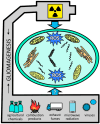Environmental Hazards and Glial Brain Tumors: Association or Causation?
- PMID: 40806554
- PMCID: PMC12347831
- DOI: 10.3390/ijms26157425
Environmental Hazards and Glial Brain Tumors: Association or Causation?
Abstract
Progress in establishing environmental risk factors and, consequently, prophylactic measures for glial tumors, particularly for glioblastomas, is of utmost importance, considering the dismal prognosis and limited treatment options. This report surveyed updates on established and recently identified factors that can predispose a patient to glioma formation while highlighting possible mechanistic links and further research directions. In addition to established factors that increase the risk of glioma, i.e., brain irradiation and several genetic syndromes, another group consists of likely factors contributing to such risks, such as the use of tobacco and those yielding ambiguous results (e.g., UV exposure). Oxidative stress is a common denominator for several types of exposure, and a mechanistic background for other factors remains elusive. Nevertheless, the analysis of clinical and basic research strongly suggests that, apart from the effect of environmental stressors on DNA alterations and mutation burden, the impact of modifying the tumor microenvironment should be considered. Identifying the involvement of environmental hazards in gliomagenesis and glial tumor progression would lower overall risk by modifying clinical practice, patient management, and lifestyle choices. Further verifying the environmental hazards in glioma formation and progression would have far-reaching implications for neurologists, neurosurgeons, and patients.
Keywords: environmental hazards; glioblastoma; glioma; oxidative stress; risk of glioma.
Conflict of interest statement
The authors declare no conflicts of interest.
Figures


Similar articles
-
Prescription of Controlled Substances: Benefits and Risks.2025 Jul 6. In: StatPearls [Internet]. Treasure Island (FL): StatPearls Publishing; 2025 Jan–. 2025 Jul 6. In: StatPearls [Internet]. Treasure Island (FL): StatPearls Publishing; 2025 Jan–. PMID: 30726003 Free Books & Documents.
-
Management of urinary stones by experts in stone disease (ESD 2025).Arch Ital Urol Androl. 2025 Jun 30;97(2):14085. doi: 10.4081/aiua.2025.14085. Epub 2025 Jun 30. Arch Ital Urol Androl. 2025. PMID: 40583613 Review.
-
The Black Book of Psychotropic Dosing and Monitoring.Psychopharmacol Bull. 2024 Jul 8;54(3):8-59. Psychopharmacol Bull. 2024. PMID: 38993656 Free PMC article. Review.
-
Short-Term Memory Impairment.2024 Jun 8. In: StatPearls [Internet]. Treasure Island (FL): StatPearls Publishing; 2025 Jan–. 2024 Jun 8. In: StatPearls [Internet]. Treasure Island (FL): StatPearls Publishing; 2025 Jan–. PMID: 31424720 Free Books & Documents.
-
[Guidelines for the prevention and management of bronchial asthma (2024 edition)].Zhonghua Jie He He Hu Xi Za Zhi. 2025 Mar 12;48(3):208-248. doi: 10.3760/cma.j.cn112147-20241013-00601. Zhonghua Jie He He Hu Xi Za Zhi. 2025. PMID: 40050074 Chinese.
References
-
- Ostrowski R.P., He Z., Pucko E.B., Matyja E. Hemorrhage in brain tumor—An unresolved issue. Brain Hemorrhages. 2022;3:98–102. doi: 10.1016/j.hest.2022.01.005. - DOI
-
- Obrador E., Moreno-Murciano P., Oriol-Caballo M., López-Blanch R., Pineda B., Gutiérrez-Arroyo J.L., Loras A., Gonzalez-Bonet L.G., Martinez-Cadenas C., Estrela J.M., et al. Glioblastoma Therapy: Past, Present and Future. Int. J. Mol. Sci. 2024;25:2529. doi: 10.3390/ijms25052529. - DOI - PMC - PubMed
-
- Central Nervous System Tumours: Who Classification of Tumours. 5th ed. Volume 6. IARC Publications; Lyon, France: 2022. p. 584.
Publication types
Grants and funding
LinkOut - more resources
Full Text Sources

